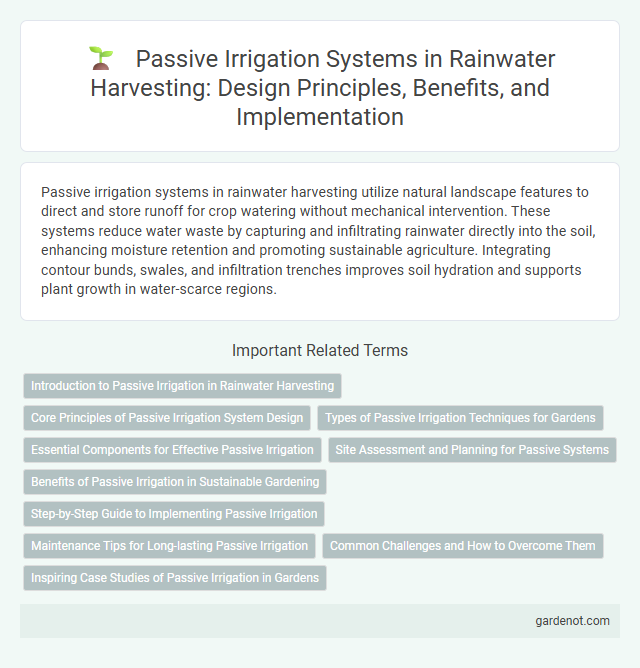Passive irrigation systems in rainwater harvesting utilize natural landscape features to direct and store runoff for crop watering without mechanical intervention. These systems reduce water waste by capturing and infiltrating rainwater directly into the soil, enhancing moisture retention and promoting sustainable agriculture. Integrating contour bunds, swales, and infiltration trenches improves soil hydration and supports plant growth in water-scarce regions.
Introduction to Passive Irrigation in Rainwater Harvesting
Passive irrigation systems in rainwater harvesting utilize natural gravity flow and soil moisture retention to distribute collected rainwater directly to crops. These systems reduce the need for mechanical pumps by channeling water through trenches, swales, or permeable surfaces, enhancing groundwater recharge and minimizing runoff. By optimizing soil absorption and maintaining consistent moisture levels, passive irrigation supports sustainable water management and improves crop yields.
Core Principles of Passive Irrigation System Design
Passive irrigation systems rely on gravity and natural soil absorption to efficiently distribute collected rainwater without mechanical pumps. Core principles include optimizing topography to guide water flow, selecting soil types with high infiltration rates, and designing storage elements that maximize water retention and minimize evaporation. Effective integration of vegetation further enhances water absorption and reduces runoff, ensuring sustainable irrigation.
Types of Passive Irrigation Techniques for Gardens
Passive irrigation techniques for gardens include mulch application, which conserves soil moisture by reducing evaporation and regulating soil temperature. Contour trenches and swales capture and slow down rainwater runoff, allowing it to infiltrate the soil and promote deep root growth. Additionally, keyline design optimizes water distribution across sloped landscapes, enhancing moisture retention and minimizing erosion in garden areas.
Essential Components for Effective Passive Irrigation
Essential components for effective passive irrigation include catchment surfaces, conveyance channels, and infiltration areas designed to capture and distribute rainwater efficiently. Incorporating filtration units prevents sediment clogging, while storage reservoirs maintain water availability during dry periods. Proper land grading and soil permeability assessments enhance water absorption, ensuring optimal moisture retention for crops.
Site Assessment and Planning for Passive Systems
Site assessment for passive irrigation systems involves analyzing soil type, slope, and water flow patterns to optimize rainwater capture and distribution. Planning includes identifying natural contours and selecting strategic locations for swales, trenches, or basins to maximize infiltration and minimize erosion. Properly designed passive systems enhance groundwater recharge and improve soil moisture retention for sustainable crop growth.
Benefits of Passive Irrigation in Sustainable Gardening
Passive irrigation systems enhance sustainable gardening by efficiently capturing and distributing rainwater directly to plant roots, reducing water waste and minimizing the need for supplemental watering. These systems promote soil health by maintaining consistent moisture levels, which supports deep root growth and increases plant resilience during drought conditions. Utilizing passive irrigation conserves groundwater resources and lowers water bills, aligning with eco-friendly landscaping practices and long-term environmental sustainability.
Step-by-Step Guide to Implementing Passive Irrigation
Implementing a passive irrigation system begins with assessing the site's topography and soil type to ensure effective water capture and distribution. Next, design water catchment areas such as swales or terraces to slow runoff and enhance infiltration. Finally, integrate vegetation suited to the local climate to maximize water absorption and reduce evaporation, optimizing rainwater harvesting efficiency.
Maintenance Tips for Long-lasting Passive Irrigation
Regular inspection and cleaning of rainwater collection surfaces and channels prevent blockages from debris, ensuring efficient water flow in passive irrigation systems. Checking for leaks or cracks in pipes and storage tanks minimizes water loss and maintains system integrity. Seasonal maintenance, including the removal of sediment and repairing worn components, extends the lifespan and effectiveness of passive irrigation installations.
Common Challenges and How to Overcome Them
Passive irrigation systems in rainwater harvesting often face challenges such as uneven water distribution, soil erosion, and clogging of channels due to debris buildup. Implementing regular maintenance schedules, designing proper grading for uniform flow, and incorporating filtration barriers effectively mitigate these issues. Selecting native, drought-resistant plants further enhances system resilience by improving soil stability and reducing water runoff.
Inspiring Case Studies of Passive Irrigation in Gardens
Passive irrigation systems utilize rainwater harvesting to sustainably nourish gardens without mechanical intervention. Notable case studies include the Dharavi slum in Mumbai, where simple earth contouring and pond systems harvest rainwater, significantly boosting urban agriculture yields. In Cape Town, South Africa, passive irrigation through rooftop rain gardens has improved water efficiency, reducing reliance on municipal supplies during droughts.
Passive irrigation system Infographic

 gardenot.com
gardenot.com